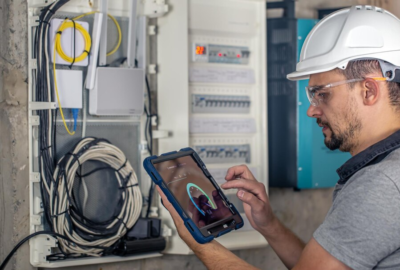Factors Affecting Healthcare App Development Cost
Have you ever wondered why the expenses associated with developing healthcare apps vary so much? The cost of developing these digital solutions varies greatly, ranging from basic telemedicine systems to sophisticated symptom monitors. However, what variables really affect how much it costs to create healthcare apps?
This article introduces you to the intricate realm of healthcare app development expenses. Knowing what influences price is essential whether you work as an app developer, a healthcare practitioner looking at digital options, or a company trying to provide better patient care. Discover how to manage financial caution with these cost factors while developing healthcare apps.
Mobile App Development connects your creative idea to a portable device that has the power to completely transform user experiences.
Table of Contents
Overview of the HealthTech Market
The worldwide mHealth market is anticipated to bring in about $119.5 billion by the end of 2024, and by the end of 2028, it is anticipated to have grown to around $400 billion.
In the event that the present trend continues, Deloitte projects that healthcare spending would almost quadruple to over $12 trillion by 2040, or 26% of GDP.
In January 2022, Sage Growth Partners performed a study on behalf of Rhythm and discovered that 57 provider organizations use remote patient monitoring (RPM) to monitor their patients’ vital signs while they are at home. Precedence Research projects that the worldwide home diagnostics market will grow from its projected $5.42 billion in 2021 to $8.15 billion in 2030.
Factors Affecting the Cost of Developing Healthcare Apps:
Business Model Type
Globally, customers spend over 22.6 billion USD on mobile applications. Furthermore, every year, at least 178 billion applications are downloaded; by 2022, it’s predicted that 258 billion will have been downloaded. These numbers show the startling amount of money spent on various components of business app development services.
The company, the intended customer base, and the products that form the framework of the app budget design are essential components. The process takes longer the more complex the business application model requires. This implies that the price will rise in tandem with time.
If it’s a customer service model, it becomes a costly transaction since more external APIs are needed. For example, a mobile app for internal operations has less features and user experience elements than an eCommerce app. The mobile software features of social media sites like Facebook and Instagram are not the same as those of applications like Uber.
Features and Complexity
The cost of developing a healthcare app is mostly determined by its features and complexity. More complex features, such as connection with electronic health record (EHR) systems, real-time data monitoring, appointment scheduling, medication reminders, and telemedicine capability, might result in a significant increase in the overall development time and cost.
Because of the lengthier development periods, platform support requirements, data security measures, regulatory compliance requirements, and integration requirements with existing healthcare systems, creating a medical app with sophisticated features and advanced functionality comes at a greater cost.
Social App Building Platforms are the Legos of the digital age, empowering anyone to create custom online communities for any shared interest.
Security and Hosting
Massive volumes of data must be safely exchanged via mobile apps. A security breach may have disastrous effects on the organization, regardless of what the breach involves: personnel information, user search criteria, private commercial transactions, or anything else. It’s crucial to choose a reputable app hosting company with cutting-edge security.
Choosing the appropriate servers becomes crucial when taking the size of the business and the volume of online traffic into account. Renting dedicated servers with cutting-edge multi-layered security is necessary to provide uninterrupted, first-rate service. This option is advised even though it is more costly than shared hosting.
Investing in app security is always worthwhile, regardless of the cost. Using strict security standards and implementing multi-level authentication can secure user trust and make sure your money is effectively spent.
Upgrades and Upkeep
For mobile apps to perform at their best, developers must provide frequent updates, maintenance, and extensive technical support. Companies that want to stay ahead of the technological curve must upgrade their app’s features and integrations, which may result in higher costs even after launch.
Regular API maintenance is essential for enterprise-level applications in order to improve user experience and continuously optimize the apps. Similarly, managers in charge of application maintenance have the challenging task of getting rid of hidden faults and backdoors. It thus needs ongoing upkeep and frequent evaluation.
Design and functionality of UI/UX
A strong UX UI design is necessary for the effective development of a healthcare application. Making something original and out of the ordinary has unanticipated hurdles, but the benefits outweigh them all. Your app will make a lasting impact on users if it has push notifications, icons, graphics, or customisation. Long-term customer interest will be piqued and maintained by a well created design.
Combining Health Systems with Integration
By combining diverse parts and technologies including electronic health records (EHRs), telemedicine, and data analytics platforms, which may optimize processes and enhance patient outcomes, health systems integration considerably reduces healthcare development costs.
Successful integration with health systems requires significant financial expenditures due to infrastructure compatibility concerns, data security considerations, interoperability issues, hardware requirements, regulatory compliance demands, and ongoing maintenance expenses.
Notwithstanding these costs, effective integration can enhance the quality of care by promoting improved patient data access, improved decision-support tools, streamlined provider workflows, enhanced care team collaboration, reduced patient testing or treatment duplication, and increased process efficiency in the healthcare delivery system.
Mobile App Development Company Newyork optimizes digital experiences and spurs innovation in a range of sectors by providing customized mobile solutions that cater to a variety of people and companies in New York.
Changes in Scope
If a project’s scope is changed while it’s being carried out, the cost of developing healthcare infrastructure also changes. More work and resources are usually required as a consequence. Think of things like functional adjustments, additional needs that weren’t originally considered, or design alterations. Every change in scope requires more planning, analysis, and testing, which is costly and time-consuming.
These changes may require adjusting software or infrastructure components already in place, which might reduce development costs. Project delays may result from scope modifications since they need more effort from developers to include new features or functions into the system. This might cause a shortage of resources and prolong the development period.
How Much Does It Cost to Develop a Healthcare Application?
Building a healthcare application might be expensive depending on the aspects we covered before. It’s crucial to realize, however, that developing applications for the healthcare industry is a complicated and heavily regulated process, and expenses may mount up rapidly.
For a more accurate estimate of the cost of developing a healthcare app, we advise contacting experienced developers or healthcare software development firms. They will assess your requirements, design a comprehensive project plan, and provide a cost estimate based on those goals and demands.
When creating healthcare applications, quality, security, and regulatory compliance must come first, even if cost is also a major factor. This will ensure both the success of your application in the healthcare industry and the safety and well-being of the patients.
In summary
A healthcare app’s development costs are influenced by a number of factors. These include the app’s functionality and complexity, the technology used, the degree of customization, and the experience and training of the development team. Furthermore, the final cost may also be impacted by any regulations that must be followed. When building their applications, healthcare providers need to take these factors into account and collaborate with a skilled development team to guarantee they have an app that satisfies their needs without going over budget. At Linkitsoft, Healthcare businesses may create effective and cost-effective applications that enhance patient care while optimizing workflows by carefully weighing these criteria and making informed choices.









